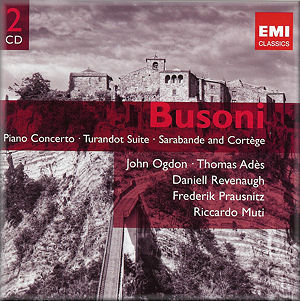 |
 |
|


alternatively
CD: MDT
|
Ferruccio BUSONI
(1866-1924)
Piano Concerto, Op. 39 [68:41]
Berceuse élégiaque, Op. 42 [8:07]
Turandot Suite, Op. 41 [24:18]
Sarabande and Cortège - Two Studies for Doktor Faust, Op.
51 [19:01]
Sonatina ad usum infantis (Sonatina No. 3) [7:39]
Ten Variations on Chopin’s Prélude in C minor [8:52]
Turandots Frauengemach (Intermezzo) [3:27]
Sonatina No. 6 (Chamber Fantasy on Bizet’s Carmen) [7:33]
 John Ogdon (piano), Thomas Adès (piano)
John Ogdon (piano), Thomas Adès (piano)
Royal Philharmonic Orchestra/Daniell Revenaugh
New Philharmonia/Frederick Prausnitz
Orchestra Filarmonica della Scala/Riccardo Muti
rec. 1967-1993. London, Milan. ADD/DD
 EMI CLASSICS 4563242 [76:56 + 71:11]
EMI CLASSICS 4563242 [76:56 + 71:11] 
|
|
|
It can only be Busoni’s ‘difficult to place’
reputation that has held back his music from the concert hall
and recording studio. Italian by birth and German by musical
training, Busoni was much admired by progressives such as Schoenberg,
Weill and Varèse. The effect of these factors was exacerbated
by his pan-European career as a pianist, teacher and critic
which took him as far afield as Russia, Finland and Switzerland.
Even allowing for these factors the unsettled, uneasy, quality
of his music has not stood the test of time well.
Thankfully, this bumper double-CD set will go a long way towards
restoring Busoni’s reputation. It includes his most celebrated
orchestral works, and several shorter piano pieces which reveal
his intelligent, if idiomatic, writing for the instrument. The
downside is that the contents of the discs are culled from a
variety of earlier recordings dating from 1967 onwards, with
three different orchestras and conductors and two piano soloists.
This rules out a uniformity of interpretation and does not help
the listener build up a clear understanding of the composer’s
oeuvre. But what we have here is well worth exploring.
The first disc is the better of the two, dominated by Busoni’s
huge piano concerto of 1903-04. Lasting well over an hour, and
calling for a male chorus in the fifth and final movement, it
is a massive testament to Busoni’s mastery of orchestral
writing, structural control and harmonic invention. Clearly
influenced by Brahms, Liszt and even Beethoven, the concerto
also points towards the more angular, ironic style of Prokofiev
- whose own first piano concerto was premiered around the same
time, in 1903. John Ogdon manages to pull all the concerto’s
disparate elements together, presenting the score with brilliant
panache and a certain sense of unease. He is ably supported
by the Royal Philharmonic under Daniell Revenaugh. The Abbey
Road studio acoustics still sound, over forty years on, clear
and resonant.
The filler work on the first disc is Busoni’s 1909 Berceuse
élégiaque. Re-worked from an earlier piano
piece to commemorate the death of his mother, the elegy moves
in a shifting web of harmonic patterns that seem to pre-figure
his magnum opus, the unfinished opera Doktor Faustus.
Two orchestral studies on the second disc - Sarabande and
Cortège - represent Busoni’s six years of interrupted
work on the opera. Again, Revenaugh and the RPO explore the
subtle range of colours in evidence in these pieces. The only
disappointment is that more excerpts from the opera could not
be included. But if sales point to a revival of interest, Busoni’s
master work might be headed for a timely new recording.
John-Pierre Joyce
|
|

